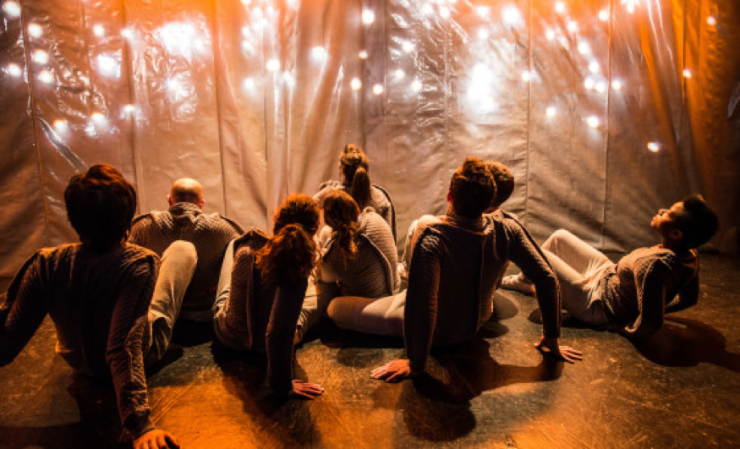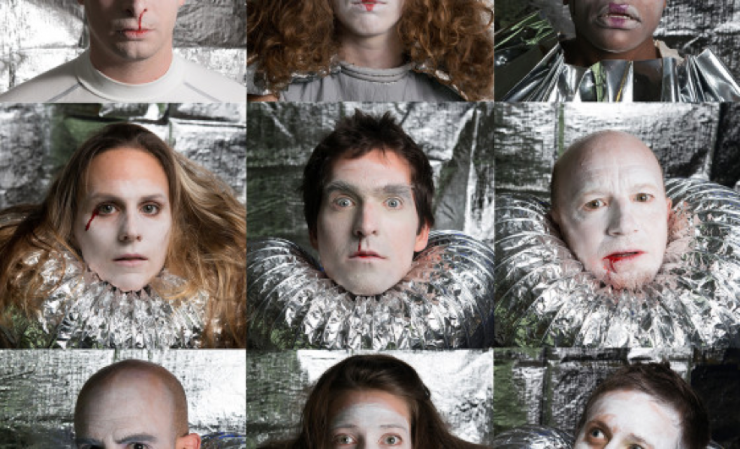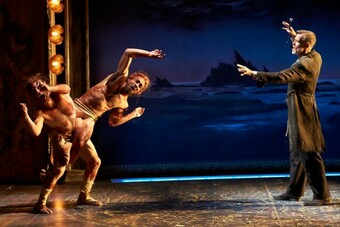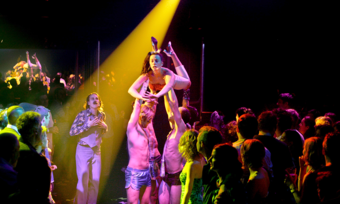Sans Everything but the Essential
Shakespeare, Space Suits, and the Power of the Human
Imagine a world without Shakespeare. Imagine a world that has forgotten the concept of story. In Sans Everything, a movement and improvisation-centered piece by Strange Attractor Theater Company (and featuring artists from Lightning Rod Special), human form has been surrendered in favor of disembodied intelligence. The theory of “The Singularity” popularized by Ray Kurzweil, describes a hypothetical future when information technologies advance so quickly and autonomously that they lead mankind to a consciousness beyond biology. To me (and to most theatre enthusiasts, I assume), this is a terrifying idea. That we could exist without individuality, without bodies or minds, without losing the value and beauty of life seems impossible. Strange Attractor tackles this hypothetical situation with intelligent choices, equanimity, and a tremendous sense of play. On a ship offering the human life cycle as an entertainment experience, the disembodied intelligence takes form as a woman, Orlando (the wide-eyed Alice Yorke), and a man, Breathe (Jed Hancock-Brainerd, endearingly off-beat). Orlando re-discovers As You Like It, and brings the life-changing concept of story back to the ship.
The concept alone makes Strange Attractor’s endeavor bold and brilliant. It is a re-staging of Shakespeare, an improvisational theatre exercise, and a meta-conversation about theatre’s place in storytelling and culture. Perhaps we have experienced Shakespeare in space before (will I ever forget the poster for the 1960s space rom-com Midsummer Night’s Dream that hung outside the girls’ bathroom at my alma mater? Oof.), but this time, it’s no gimmick. Strange Attractor cites the wane of Shakespeare in British schools as an influence on their production (the company is American, with home bases in Juneau, Providence, and Philadelphia). Reading and performance of the bard has been whittled away in favor of standardized test preparation. While our national pride does not have the stake in Shakespeare that England’s does, the arts are frequently pushed out of the class room in homage to the Test Score Gods. Sans Everything is not set in space for fun, but to consider the interaction between consciousness and identity, individuality and collectivity, pacifism and stasis.
Sans Everything depicts the future version of human life forms as past desire. The structure of life on the ship is akin to socialism, sans money, work, need, or progress. Minimalism is often favored by small, fringe companies, both for artistic and pecuniary reasons. Here, it also translates the blandness of a future without human form or stories. The ship does not need manning; there are no lit-up toggles or emergency buttons. In the spacious black box of The Charlestown Working Theater (known for embracing the new and the fringe), plastic curtains have been erected as the homogenous interior of the ship, slit on stage right and left to allow entry and exit. The physical has been transcended. Before storytelling re-emerges in this world, the craft and its inhabitants are “empty, activated by harmonics, boundless, two-thirds gravity, self-sustaining” according to the actors themselves (more about their process here). Without stories, life is placid and harmonious. These lifeforms have come to a state of peace through technology.

While smart phones, GPS systems, and 3D printing are making some parts of life easier, many worry that we are losing our ability to pay attention, to be still, to think deeply. If we asked for a word to describe our relationship to technology, “obsessive” would come up more often than “symbiotic.” It’s interesting to think about how meditative and aware of their bodies and surroundings the actors in this piece had to be, as they improvised scenes and created the different rooms of the ship through their bodies and voices, when they were playing characters closer to robots than humans (in the plant room, everyone wanders and hums; while sleeping, they stand with legs together and arms a-drift). Clara Welshahn, who initiated the idea for the project, glided from moment to moment in an intense state of meditation, which kept her awake and alive to every sensation that arose. While many actors use mindfulness and improvisation techniques to find character and to keep performances fresh, they are usually hidden from the audience under traditional forms of drama and story, as the secret key is tucked under the magician’s tongue. In Sans Everything, the audience witnesses these techniques first-hand. Theatre is the technology we use to connect to our inner selves.
Sans Everything closes the divide between rehearsal and performance. This level of honesty entrusts the audience with a status equal to that of the actors.
The overall structure of the show was set (discovered over months of work), but each scene was completely improvised using exercises (herein lies the benefit, as well as the danger, of having a company comprised exclusively of actors!). While for some, this mode of theatrical presentation could seem self-indulgent, I found it to be extremely brave. Perhaps you have heard a phrase akin to “the way you rehearse is the way you’ll perform.” For the artist, the practice must be the art as much as the performance is, for it comprises the bulk of the work. By closing the divide between rehearsal and performance, Sans Everything entrusts the audience with a status equal to that of the actors. We were all equally surprised by what came next, just as children are when they play. And while Strange Attractor often favors this mode of production, in this case, the content mimics the form—the AI must discover their story moment to moment, having no previous reference.
What the nine AI forms do have on the ship is routine. They wear the same gray sweat-suit with fin-like sleeves, follow the same routine (wake, exercise, spend time in the plant room, then the research room, eat, sleep), and always seem vaguely pleased. Once As You Like It insists itself into the minds of Orlando and Clara, once they share what they have discovered with the others, the play explodes in a colorful, strange euphoria of self-expression in the form of hot pink fanny packs, white face paint, guitar riffs, cave man loin cloths, and ear biting. Suddenly, there is conflict, death, arousal, and desire! Whereas the lifeforms existed in a happy clump before (literally, at times), there are now two tribes (the thespians and the warriors), whose costume and behavior signify their place in a pecking order.
This is a surprising shift. Don’t we tell stories in order to create harmony? Isn’t the point to create connection between disparate peoples and to help us grapple with life’s thorniest issues in a safe space? On the other hand, a world without story has to be a world without conflict, for conflict is the backbone, the beginning of story, and those who have moved past conflict necessarily lose this piece of artistic anatomy. Strange Attractor does not characterize the pre-story or post-story parts of the show as distinctly superior or inferior, but lets the audience witness both and decide for ourselves whether we would prefer a Shakespeare-less hive-mind existence or a life of verve, culture, and a little blood.
…A world without story has to be a world without conflict, for conflict is the backbone, the beginning of story.
I have not detailed how, specifically, Shakespeare is encountered, because it is not explicit in the production. It seems to spring from an internal recess, and once the thread is pulled, the whole play comes tumbling after it. This indicates that storytelling is inherently human, a part of our biological makeup. It cannot be resisted.

Personally, I found the outburst of expressiveness powerful and endearing. It was like seeing a shy niece discover slam poetry. The very serious nouveau-thespians transform themselves by commandeering pieces of the ship, turning air ducts into Elizabethan ruffs, orange electrical wires into epaulets, and plastic coverings into voluminous gowns. Some may call this destructive. I call it resourceful, beautiful. When the thespians present a duel scene in attempt to communicate with the warrior tribe, the latter join in, learning the lines through repetition. At the end of the arc, theater is shown as giving individuals a sense of who they are and as creating culture. For anyone afraid that the future holds a world without ethos, without depth, without Shakespeare, Strange Attractor and Lightning Rod Special provide a hopeful message in a very bold package: storytelling is part of our genetic makeup which cannot be lost, even if we cease to be composed of DNA.








Comments
The article is just the start of the conversation—we want to know what you think about this subject, too! HowlRound is a space for knowledge-sharing, and we welcome spirited, thoughtful, and on-topic dialogue. Find our full comments policy here
What a great article, it really captures the spirit of the piece, which I also got to see at Charlestown Working Theater. I had no idea they improvised through many of those scenes. Incredible. The curtain call from this show was totally profound, thanks for writing this article because I'd forgotten all about it. (I'd love to hear your thoughts on it, Shari!) I wish more people had come to see this piece, the house was sparse when I saw it. I hope this company (which I think co-developed the show with another company?) comes through town with future work. Very very cool. --Josh Platt